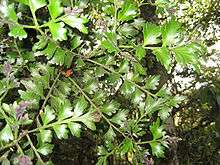Phyllocladus
Phyllocladus, the celery pines, is a small genus of conifers, now usually treated in the family Podocarpaceae.[1] Species occur mainly in New Zealand, Tasmania, and Malesia in the Southern Hemisphere, though P. hypophyllus ranges into the Philippines, a short way north of the equator.
| Phyllocladus | |
|---|---|
| Phyllocladus alpinus | |
| Scientific classification | |
| Kingdom: | Plantae |
| Clade: | Tracheophytes |
| Division: | Pinophyta |
| Class: | Pinopsida |
| Order: | Pinales |
| Family: | Podocarpaceae |
| Genus: | Phyllocladus Rich. ex Mirb. |
| Species | |
|
Five; see text | |
Characteristics
They are small to medium-sized trees, reaching 10–30 m tall, or sometimes small shrubs. The main structural shoots are green for 2–3 years, then turn brown as the bark thickens. The leaves are sparse, tiny, scale-like, 2–3 mm long, and only green (photosynthetic) for a short time, soon turning brown. Most photosynthesis is performed by highly modified, leaf-like short shoots called phylloclades; these develop in the axils of the scale leaves, and are simple or compound (depending on species). Simple phylloclades are rhombic, 2–5 cm long, and compound phylloclades are up to 20 cm long and subdivided into five to 15 leaflet-like phylloclades 1–3 cm long. The seed cones are berry-like, similar to those of several other Podocarpaceae genera, notably Halocarpus and Prumnopitys, with a fleshy white aril; the seeds are dispersed by birds, which digest the soft, fleshy aril as they pass the hard seeds in their droppings.
 Phylloclades of P. trichomanoides
Phylloclades of P. trichomanoides A seedling of P. aspleniifolius with needle-like juvenile leaves
A seedling of P. aspleniifolius with needle-like juvenile leaves- Pollen cones of P. alpinus
_cones_(8711563882).jpg) Seed cones of P. aspleniifolius
Seed cones of P. aspleniifolius
Taxonomy
Phyllocladus is sufficiently morphologically distinct from the other Podocarpaceae genera that some botanists have treated them separately in their own family, Phyllocladaceae.[2] However, while at least one molecular phylogenetic analysis found Phyllocladus to be sister to Podocarpus sensu stricto [3] and another was equivocal on its position relative to Podocarpaceae s.s.,[4] two more recent molecular phylogenetic analyses have placed Phyllocladus within Podocarpaceae as a sister taxon to Lepidothamnus.[5][6] Morphological analysis supports this placement, and therefore it has been suggested that the distinctive phylloclades in the genus are a synapomorphy.[6]
The five species are genetically distinct, and probably arose between 5 and 7 million years ago.[4]
Species
- Phyllocladus alpinus (P. trichomanoides var. alpinus) - mountain toatoa (New Zealand)
- Phyllocladus aspleniifolius - celery-top pine (Tasmania)
- Phyllocladus hypophyllus - Malesian celery-pine (New Guinea to Borneo and Philippines)
- Phyllocladus toatoa - toatoa (New Zealand)
- Phyllocladus trichomanoides - tanekaha (New Zealand)
References
- James E. Eckenwalder. 2009. Conifers of the World. Timber Press: Portland, OR, USA. ISBN 978-0-88192-974-4.
- Christopher N. Page. 1990. "Phyllocladaceae" pages 317-319. In: Klaus Kubitzki (general editor); Karl U. Kramer and Peter S. Green (volume editors) The Families and Genera of Vascular Plants volume I. Springer-Verlag: Berlin;Heidelberg, Germany. ISBN 978-0-387-51794-0
- William T. Sinclair, R. R. Mill, M. F. Gardner, P. Woltz, T. Jaffré, J. Preston, M. L. Hollingsworth, A. Ponge, and M. Möller. 2002. "Evolutionary relationships of the New Caledonian heterotrophic conifer, Parasitaxis usta (Podocarpaceae), inferred from chloroplast trnL-F intron/spacer and nuclear rDNA ITS2 sequences". Plant Systematics and Evolution 233(1-2):79-104. doi:10.1007/s00606-002-0199-8
- Steven J. Wagstaff. 2004. "Evolution and biogeography of the austral genus Phyllocladus (Podocarpaceae)". Journal of Biogeography 31(10):1569-1577.
- Ed Biffin, Timothy J. Brodribb, Robert S. Hill, Philip Thomas and Andrew J. Lowe. 2012. "Leaf evolution in Southern Hemisphere conifers tracks the angiosperm ecological radiation". Proceedings of the Royal Society B Biological Sciences 279:341-348. doi: 10.1098/rspb.2011.0559.
- Patrick Knopf, Christian Schulz, Damon P. Little, Thomas Stutzel and Dennis W. Stevenson. 2012. "Relationships within Podocarpaceae based on DNA sequence, anatomical, morphological, and biogeographical data". Cladistics 28: 271–299. doi:10.1111/j.1096-0031.2011.00381.x
Sources
- Quinn, C. J. & Price, R. A. 2003. Phylogeny of the Southern Hemisphere Conifers. Proc. Fourth International Conifer Conference: 129-136.
External links
| Wikimedia Commons has media related to Phyllocladus. |
- Gymnosperm Database - Phyllocladus